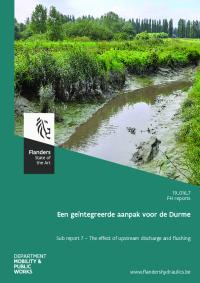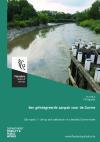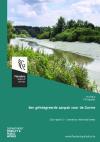Gedaan met laden. U bevindt zich op: Een geïntegreerde aanpak voor de Durme. Sub report 7 – The effect of upstream discharge and fushing
Een geïntegreerde aanpak voor de Durme. Sub report 7 – The effect of upstream discharge and fushing
In the Durme valley, various management measures are foreseen, such as implementation of new intertidal areas, changes in the upstream flushing regime and deepening of the river. In this report, the effects of the changes in upstream discharge and upstream deepening on the hydrodynamics of the Durme river are evaluated using a hydrodynamic Telemac model of the Durme river.
A series of model runs was carried out in which the upstream discharge was varied and the upstream bathymetry was altered. The results show variable responses of the water level, current velocity and tidal asymmetry. As the changes occur at the river upstream, the effects on river hydrodynamics are stronger in the upstream river section.
Upstream deepening causes higher velocity asymmetry within the deepened section, which enhances flood dominance (for case with small upstream discharge) or weakens ebb dominance (higher upstream discharge scenarios). Further downstream, the effect reverses and velocity asymmetry weakens. Higher river flow naturally results in a decrease of flood velocity and an increase of ebb flow. The flood dominant tidal asymmetry is therefore weaker for higher upstream discharge. An increase in the river discharge could even result in a transition from flood dominance to ebb dominance in some river sections. In terms of sediment transport, this could imply that accumulated sediment can be redistributed within the Durme river.

Lees de publicatie
- Publicatiedatum
- April 2024
- Publicatietype
- Rapport
- Thema's
- Scheepvaart, waterwegen en zeewezen
- Auteur(s)
- D. Nguyen, J. Stark, D. Meire
- Reeks
- FH reports 19_016_7

